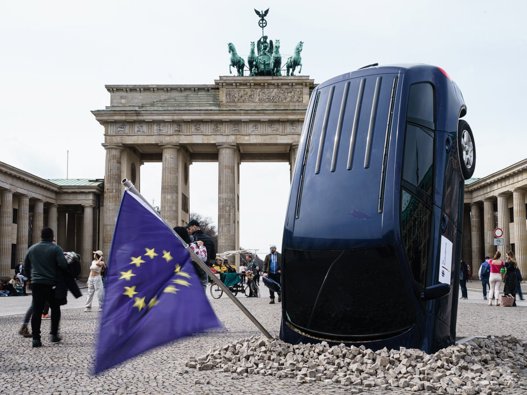
Germany’s States Push EU to Ease 2035 Engine Ban
Germany’s regional leaders demand flexibility in the EU’s 2035 car phase-out to protect industry and maintain support for electric mobility.
The leaders of Germany’s 16 federal states are calling for more flexibility in the European Union’s planned 2035 ban on new combustion-engine cars, warning that a rigid phase-out could harm the country’s industrial base and public support for electric vehicles. Meeting in Mainz for a three-day Minister Presidents’ Conference (MPK), the state premiers agreed on a series of positions ranging from climate and energy policy to social welfare, migration, infrastructure, and wildlife management. Key outcomes included a demand to loosen the 2035 combustion-engine ban, plans to draft welfare state reforms by December, a push for tougher measures on irregular migration, calls for greater federal investment in ports, and steps to ease restrictions on wolf population control. The tone of the discussions was described as official and pragmatic, with leaders from different parties largely united on economic priorities.
State Leaders Demand Flexibility in 2035 Engine Ban
Germany’s regional leaders urged the EU to relax its mandate that, from 2035, only zero-emission new cars can be registered – a rule that effectively bans new gasoline and diesel vehicles after that date. In a resolution, they warned that “a rigid ban on combustion-engine technology from 2035, without regard for practical feasibility, would not only endanger industrial core competencies and the competitiveness of Germany’s automotive sector, but also undermine public acceptance of electromobility overall”. While 2035 remains “the target date” for climate-neutral transportation, the state governments insist “we need flexibility” in how the goal is reached, said conference chairman Alexander Schweitzer, Minister President of Rhineland-Palatinate (SPD).
Schweitzer stressed that “the future is electric, there’s no doubt about it”, but under certain conditions a transition period for combustion engines beyond 2035 should be possible using climate-friendly fuels and technologies. “It’s important in climate policy that industry doesn’t run out of steam along the way,” he said, emphasizing that highly efficient engines running on synthetic or biofuels, as well as hybrids, could serve as bridge technologies. In their joint statement, the premiers affirmed electric vehicles as a central future technology, but also noted that alternative low-carbon propulsion methods – like highly efficient combustion engines, plug-in hybrids, and range-extender EVs – will be needed to secure jobs and value creation in Germany and to achieve climate targets without breaking the industry. This stance reflects growing concerns that an inflexible ban might backfire if consumers or manufacturers are not fully ready by 2035.
Bavarian Minister President Markus Söder (CSU) hailed the conference’s stance as a victory for common sense. “The scrapping of the ban is now underway,” Söder declared, arguing that Europe’s current climate targets for 2035 are unrealistic and risk harming prosperity. He urged the federal government in Berlin to adopt the Länder’s position and push for an EU-wide compromise that allows combustion vehicles to continue in some form. Saxony’s premier Michael Kretschmer (CDU) echoed that view, saying “it is impossible to have everything fully electric by 2035”. He noted practical obstacles – from high electricity costs to insufficient charging infrastructure – that explain why many people are not sold on EVs yet. Kretschmer expressed relief at the states’ resolution, insisting that even after the EU’s deadline, new combustion cars will still be on the road in Germany thanks to this more pragmatic approach.
At the national level, Germany’s governing parties have been debating whether to advocate easing the EU ban. (Chancellor Friedrich Merz’s coalition, consisting of Merz’s center-right CDU/CSU and the center-left SPD, inherited the 2035 phase-out commitment from the previous government.) Until recently, the coalition had not settled on a common line on the issue. However, momentum appears to be shifting. Merz himself emerged from an automotive summit in October vowing to “do everything in [his] power” to prevent an abrupt shift in 2035. He argued there “must be no abrupt change” that year and encouraged Germany’s carmakers to continue exploring “all conceivable drive technologies” in parallel – a clear nod towards keeping combustion options open alongside electrification. Supporting this, SPD finance minister Lars Klingbeil signaled his party could accept exceptions to the ban, advocating “more flexibility, more pragmatism” and explicitly mentioning plug-in hybrids, range extenders, and synthetic fuel blends as viable options to incorporate into EU rules. This suggests that Berlin is moving toward the very position the Länder have now formalized.
Environmental groups and climate advocates, however, are alarmed by any weakening of the 2035 deadline. Greenpeace warned that diluting the agreed phase-out would “create more uncertainty” and slow the shift to clean mobility, thereby endangering both the climate and Germany’s auto industry in the long run. Leaders of the opposition Green Party likewise argue that prolonging combustion-engine technology comes “at the expense of innovation, competitiveness and a sustainable automotive industry”, ultimately jeopardizing jobs rather than saving them. They contend that clear direction toward electrification is needed for the industry to stay competitive with China and the U.S. Despite these warnings, Germany’s state governments — including those led by Greens — appear to be prioritizing economic pragmatism over a strict EV-only approach. Member states across the EU have similarly been grappling with this balance: Italy, Poland and others have criticized the 2035 ban, and even the European Commission has agreed to review the impact of the policy in light of industry concerns.
What exactly does the EU’s 2035 engine ban entail?
The EU regulation in question will prohibit registration of any new passenger cars or light vans that emit CO₂ from 2035 onward. In practice, that means the sale of new gasoline or diesel cars is not allowed after 2034, effectively mandating a switch to zero-emission vehicles (primarily electric or hydrogen) starting in 2035. The policy is a cornerstone of Europe’s climate strategy to reach net-zero emissions by 2050. Some exemptions have been discussed – for example, allowing new vehicles that run exclusively on synthetic e-fuels – but environmental proponents note that such cases would be niche. The ban was agreed by all EU member states in 2023, though pressure is now mounting to adjust it.
Why are German states pushing back on a strict ban?
Leaders in Germany fear that a one-size-fits-all 2035 ban could have unintended economic and social consequences. They cite the country’s huge automotive sector, which employs millions, and warn that forcing a single technological pathway too quickly might erode Germany’s competitive edge. By advocating flexibility, the states want to allow “transitional technologies” – like high-efficiency combustion engines powered by carbon-neutral fuels, or hybrid systems – to continue alongside electric vehicles for a period. They argue this could prevent job losses and give consumers affordable low-carbon options, bolstering public acceptance of the overall shift to cleaner cars. In short, it’s a bid to balance climate goals with economic realism, ensuring the electric future arrives with less disruption. Critics, on the other hand, see this as delaying necessary action and risking climate targets, which highlights the tension between environmental urgency and industrial caution.
Welfare State Reforms on the Horizon
Economic concerns dominated much of the Mainz conference, extending beyond industry into Germany’s robust social welfare system. The state premiers discussed the need to modernize the Sozialstaat (welfare state) amid growing fiscal pressures, although they did not reach a concrete resolution in this area. “We want a strong, efficient, caring welfare state,” said MPK chairman Alexander Schweitzer, emphasizing that reform should not be about stripping away benefits from people. Instead, the focus is on streamlining administration and cutting red tape to save costs. It makes little sense, for example, that housing allowances and child benefits are paid out by separate offices – an inefficiency that could be fixed to reduce overhead. Schweitzer noted that the welfare state’s “back office has become a bit too large and too expensive”, and there are opportunities to modernize without citizens feeling neglected. What is “not needed,” he insisted, is any kind of “fetish for cuts” that would arbitrarily slash support programs.
This debate comes as Germany’s social spending has reached record levels due to an aging population, slowing economic growth, and recent crises. According to economists, Germany now spends around €1.3 trillion on social welfare annually – roughly 31% of GDP – a share that has climbed in the past decade. Chancellor Merz recently warned that the welfare model is “no longer economically sustainable” without reforms, urging an “autumn of reform” this year. The states appear to agree change is needed, but are keen to ensure it doesn’t come at the expense of society’s most vulnerable. Their approach centers on “whoever orders, pays” – meaning, if the federal government mandates new social benefits or tax cuts, it should cover the costs so that states and towns aren’t stuck with the bill. (This issue of unfunded mandates has been a point of friction, especially after Berlin’s recent moves like increasing child payments or cutting VAT on food, which left lower governments bearing some costs.) Better coordination and digitalization of social services is another theme – the idea that modern tech could merge duplicate bureaucracies and deliver aid more efficiently to citizens.
By December, the Länder aim to produce a set of welfare reform proposals in time for the next MPK meeting, which will include Chancellor Merz in Berlin. Schweitzer has been tasked with drafting a blueprint on behalf of his colleagues. The plan is to present ideas that can ensure the welfare state remains generous but financially viable in the long term. These could include merging certain agencies, simplifying benefit applications, and tightening administration budgets. Any politically sensitive cuts (such as to pension formulas or unemployment aid) are unlikely to be part of the states’ recommendations, given the clear stance against austerity for citizens. Instead, the message is one of reform without rupture – making the system smarter and leaner while preserving its core promise. The December talks, to be attended by Merz, will test how far the federal government is willing to go along with these suggestions. With public debt constraints back in force and defense spending rising, pressure is high to find savings, but neither the center-right nor center-left wants to be seen as dismantling the social safety net. The outcome of this reform initiative could have far-reaching implications for Germany’s budget and social contract in the coming years.
Push for Tougher Migration Enforcement
Another area where the state leaders reached unanimous agreement was migration policy – specifically, dealing with individuals in Germany who have no legal right to remain. The conference concluded that deportations to Afghanistan and Syria should be intensified “starting with criminals and [security] threats”. This marks a hardening stance: for years, Germany halted returns to these countries due to dangerous conditions (Afghanistan is under Taliban rule since 2021, and Syria remains embroiled in conflict under the Assad regime). But now, amid growing domestic debate on irregular migration, the Länder chiefs want to restart and expand removals of certain categories of offenders as a signal of law enforcement resolve. “The level of determination in tackling irregular migration – and in enforcing existing obligations to leave – is also a gauge of the public’s trust in the state,” their joint statement said. In other words, they argue that the credibility of government rests on not allowing unlawfully present individuals, especially those who commit crimes, to stay indefinitely.
This push aligns with recent federal policy changes. After a new CDU/CSU-SPD coalition took power in early 2025, the national government’s coalition agreement explicitly included resuming deportation flights to Afghanistan and Syria for convicted criminals and identified Islamist “threat persons”. In fact, Germany carried out a high-profile deportation flight to Kabul this July: 81 Afghan men with criminal records were flown out from Leipzig, the second such operation since the Taliban takeover. (The first occurred in August 2024 with 28 offenders, breaking a three-year moratorium.) Federal Interior Minister Alexander Dobrindt (CSU) coordinated that mission with Qatar’s help, given the lack of formal relations with Kabul’s new rulers. The states now “urge the federal government to enable further and regular return operations” to Afghanistan – and, for the first time, to Syria as well – focusing initially on criminals and Islamist militants.
German authorities acknowledge that returning people to Syria will be even more complex, as Berlin has no dialogue with Damascus and conditions in Syria are internationally condemned. Nevertheless, pressure from conservative-led states to make examples of serious offenders has grown, especially following some high-profile crimes. The unity of all 16 states on this position (including those governed by SPD, Greens, and Left parties, which traditionally opposed such deportations) signals how politically salient the migration issue has become across the spectrum. Still, the plan is contentious. Human rights organizations like Amnesty International and Pro Asyl blasted July’s Afghanistan flight, calling it a “violation of international law” to send people to a country where persecution and violence are rife. They argue that neither Afghanistan nor Syria can be considered safe by any stretch, and deporting even criminals there flouts humanitarian principles. The government counters that it will assess case by case, and that those removed are serious offenders (rapists, assault convicts, etc.) or extremist threats, not ordinary asylum seekers.
Looking ahead, the federal interior ministry is negotiating logistics – potentially via third countries or indirect routes – to facilitate more deportation flights. The MPK’s endorsement means state-level agencies (who often handle detention and transport of deportees) are on board to cooperate. “It must begin with criminals and dangerous individuals,” the state leaders emphasized, indicating that once a precedent is set, the scope could broaden to others under deportation orders. This reflects a broader shift in German migration politics: a move toward stricter enforcement after years of focus on integration. The coming months will show if deportations to war-torn states become routine or remain limited by legal and practical hurdles. Either way, the unanimity at Mainz sends a political message that Germany’s regions expect the federal government to get tougher on those ordered to leave.
States Seek More Federal Funds for Ports
On the economic front, Germany’s coastal states scored a win at the conference by getting all Länder leaders to back their call for increased federal investment in the nation’s seaports. All 16 Minister Presidents agreed (16–0) that the federal government must significantly raise its funding for port infrastructure, which currently stands at a modest 38 million euros per year. “Out of the 300 billion euros in the federal special fund, considerably more money needs to reach the ports,” said Patrick Dahlemann (SPD), the state chancellery chief of Mecklenburg-Western Pomerania, speaking on behalf of the conference. Dahlemann noted the unanimous resolution and added: “We expect a permanent increase over the current €38 million in the federal budget for ports.” The appeal underscores the importance of harbors like Hamburg, Bremen, and Rostock not just for the northern states but for Germany’s economy as a whole – they are critical hubs for trade, industry supply chains, and future energy imports.
Germany’s seaport operators and local governments have long argued that federal support is woefully low. The €38 million annual subsidy (shared among five coastal states) is based on an old “port upkeep” formula and covers only a tiny fraction of needed investments. In fact, the Central Association of German Seaports (ZDS) estimates that at least €500 million per year is required just to catch up with maintenance backlogs and cost inflation in port facilities. Many quays, locks and storage areas are decades old and in need of renewal. Additionally, new infrastructure is needed for the energy transition – for example, terminals to import green hydrogen or liquid natural gas, and facilities to handle offshore wind components. “The coastal states should not be left alone with these national tasks,” argued Angela Titzrath, head of Hamburg’s port and President of ZDS, noting that ports are becoming even more crucial for supply security and clean energy and thus warrant federal backing.
The united front from the states puts pressure on Berlin to allocate a share of its massive €300 billion special investment fund (originally set up for defense, climate and infrastructure) specifically to port development. The Länder want some of that money channeled into dredging projects, modernizing terminals, and improving hinterland connections (rail and road links to ports). They also see port investment as a way to stimulate growth: “The federal government must invest more in ports, also to help boost the economy,” Dahlemann said, alluding to weaker economic data lately. However, the response from Berlin so far has been cautious. The federal government’s maritime coordinator, Christoph Ploß (CDU), pointed out during a visit to Mecklenburg-Vorpommern this week that states themselves have access to new funds – specifically a separate €100 billion program for state and local infrastructure – and urged them to prioritize port projects within those budgets. (Mecklenburg-Vorpommern, for instance, is slated to receive €1.9 billion from that pot, which Ploß suggested could be directed to harbor upgrades.) This gentle nudge implies that Berlin expects a partnership approach: it may increase its contribution, but coastal states should co-invest their own resources.
For now, the MPK resolution strengthens the hand of port cities in upcoming budget negotiations. The issue has taken on strategic significance as Germany looks to diversify supply chains (the war in Ukraine and global tensions have highlighted the need for resilient ports) and to build facilities for importing cleaner energy. Germany’s ports collectively say they need around €15 billion in investment over the next decade to remain competitive and support new tasks. With this clear signal from all state leaders – from Bavaria to Schleswig-Holstein – the ball is in the federal government’s court. Observers note that port funding was also a prominent topic in recent coalition talks, so there is political momentum to do something. The scale of any funding boost will likely be hashed out in the federal budget update or the special fund allocations in the coming months.
Easing Wolf Protections to Enable Regulated Culling
Rounding out the conference’s agenda was an agreement to make it easier to manage wolf populations in Germany. The Minister Presidents called for the wolf’s protected status to be downgraded in German law “without delay”, in line with recent moves at the European level. Wolves, which had been extinct in Germany for over a century, have made a strong comeback in the past two decades under strict protections. But growing numbers of packs have led to more incidents of livestock attacks, prompting farmers and some politicians to demand action. EU law previously listed wolves as “strictly protected”, barring most interventions; however, in May 2025 the European Parliament voted to change the wolf’s status to merely “protected”, aligning with the Bern Convention and acknowledging that populations have recovered in many regions. This change – endorsed by EU member states and set to become binding – gives countries greater flexibility in controlling wolves to address regional circumstances. Member states will still be obliged to maintain a viable overall wolf population, but they will be allowed more leeway in authorizing hunts or removals of problem animals.
Germany’s state leaders want to seize this opportunity swiftly. Several Länder (notably in the rural east and north) have reported rising conflicts between wolves and agriculture. There are now estimated over 20,000 wolves in Europe, with dozens of packs in Germany, and their spread has been hailed as an environmental success. Yet with that success comes tension: farmers report hundreds of sheep, cows or horses killed by wolves each year, and fear for their livelihoods. The MPK’s resolution calls on the federal government to urgently lower the wolf’s protection status in national regulations, which would effectively make it easier to grant shooting permits and manage pack sizes. In practice, this might mean allowing shepherds or authorities to cull wolves that repeatedly prey on livestock, or establishing wolf-free zones around populated farming areas. Proponents argue that current rules are too cumbersome – often requiring case-by-case exemptions after damage is done – and that a clearer legal framework is needed to “simplify the wolf hunt” when necessary. Some states, like Lower Saxony and Brandenburg, have already petitioned for federal action on this.
Not everyone is happy about weakening protections for an iconic wild species. Conservation and animal welfare groups blasted the EU’s decision as a dangerous rollback. BirdLife International, an alliance of environmental NGOs, called the downgrading of wolf protection a “false solution to livestock depredation” and a major blow to Europe’s biodiversity commitments. They point out that scientific studies (including the EU’s own analysis) found no clear evidence that killing wolves significantly reduces attacks on farm animals – advocating instead for better fencing, herding dogs, and compensation schemes. Critics accuse politicians of scapegoating wolves for “populistic” appeal, noting that even a reduced status doesn’t mean wolves are no longer endangered in some areas. They urge continued emphasis on coexistence measures. The European Parliament itself acknowledged that member states must ensure wolves remain at a favorable conservation status and can even keep stricter national protections if needed. Germany’s Green Party environment ministers have so far trodden carefully, supporting targeted removals of aggressive wolves but warning against widespread culling.
The unanimous stance by the MPK indicates a cross-party consensus that current wolf policy needs recalibration. Even traditionally pro-environment leaders, like Baden-Württemberg’s Green premier Winfried Kretschmann, signed on to the call – likely reflecting pressure from rural communities. The federal environment ministry (led by the SPD in the Merz cabinet) has said it will examine the legal changes necessary to implement the EU directive once it comes into force. By mid-2025, the EU’s habitat rules are expected to officially shift, and Berlin would then adjust domestic wildlife law accordingly. The state leaders clearly want that done as soon as possible – “immediately,” as their statement put it – to allow this year’s autumn and winter hunting season to proceed under the new guidelines. The coming months will thus see Germany updating its conservation laws, balancing the aim of protecting an apex predator with the practical need to protect farmers’ livelihoods. In the words of one official, the goal is “to ensure the wolf’s return doesn’t mean the farmer’s demise.” Whether this new flexibility will indeed reduce conflicts – or spark new controversies – remains to be seen. Environmental observers will be watching that Germany continues to maintain its wolf population, which is still growing from near extinction, even as it grants more leeway to intervene.
Sources: evangelisch.de cleanenergywire.org europarl.europa.eu birdlife.org zeit.de lemonde.fr






